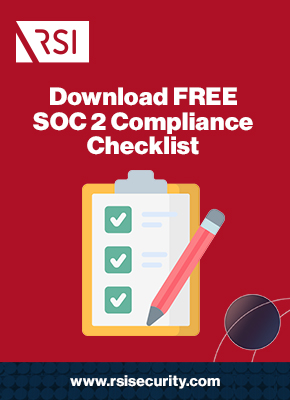Why do you need SOC 2 for providing SaaS services? SOC reports and audits can help service organizations assure clients and customers of robust, secure internal controls for managing outsourced services and associated data. Read on to learn how SOC 2 compliance can help you build trust assurance for your clients.
Why Do You Need SOC 2 as a SaaS Provider?
Strictly speaking, your SaaS organization may not need SOC 2 compliance; it may not be a legal requirement. Regardless, you should strongly consider a SOC 2 audit to optimize your organization’s security posture, assuring current or future clients of their safety in your hands.
There are two primary factors to consider regarding the benefits of being SOC 2 compliant:
- The question of who needs SOC 2 compliance and the benefits of implementation
- The inherent flexibility of SOC 2 implementation, auditing, and reporting processes
Below, we’ll walk through all of these factors and provide guidance on how to achieve full implementation in preparation for a SOC 2 audit for trust assurance.
Trust Assurance Through SOC Implementation
As the largest body of accountants, the American Institute of Certified Public Accountants (AICPA) aims to improve the effectiveness of accounting, auditing, and reporting processes. Provided by the AICPA, System and Organization Controls (SOC) audits can help service organizations demonstrate the effectiveness of internal controls to current and future clients.
For a SaaS provider, why do you need SOC 2 audits? SOC 2 audits are one of the three SOC audits (see below) that can help you assure clients that their sensitive data is safe in your hands. Specifically, SOC reporting frameworks will help you assess the security and overall effectiveness of the controls managing services provisioned to your partners.
Request a Free Consultation
Which SOC Level Does Your Organization Need?
Determining the appropriate SOC reporting for your organization depends on the types of services you provide.
The SOC Levels for service organizations include:
- SOC 1 – Designed for service organizations that provide financial services, SOC 1 reports assess the internal controls used in financial reporting for clients. There are two types of SOC 1 reports, namely:
- SOC 1 Type 1 (less rigorous testing of controls at a specific time)
- SOC 1 Type 2 (more rigorous testing of controls over a specific period
- SOC 2 – Other service organizations (e.g., SaaS and cloud service providers) rely on SOC 2 reports to demonstrate assurance to auditors about controls related to TSC criteria (see below). SOC 2 reporting includes:
- SOC 2 Type 1 (reporting on control design)
- SOC 2 Type 2 (reporting on control effectiveness)
- SOC 3 – SOC 3 reporting is similar to SOC 2 but more accessible to general audiences. SOC 3 reports can demonstrate regulatory compliance to non-technical readers.
Comparing the three types of SOC reports, why do you need SOC 2 reports? SOC 2 reporting is robust and thorough and will help assure clients of your commitment to the safety of sensitive data.

SOC 2—Type 1 or Type 2?
Most organizations aim to earn a SOC 2 Type 1 certification en route to earning Type 2. This is because Type 1 assessment resembles a “snapshot” of your security control implementation at a single point in time. Type 2 involves a much longer evaluation to assess your security controls’ ongoing effectiveness.
Build Your Reputation Amongst Clients and Publicly
SOC 2 reporting can help your organization effectively design secure and operational controls to protect sensitive client information. Successful SOC 2 reporting relies on the criteria associated with the five TSC Categories, broken down as follows:
- Security – The level to which processes can protect information against unauthorized access and disclosure. Organizations with secure controls can safeguard systems and data from potential compromise that could affect the criteria within the other four categories. Security is the only category for which there are no associated supplemental criteria.
- While Security doesn’t have any supplemental criteria, criteria that share an association with all five categories are compiled in what’s called the “common criteria” (CC Series).
- Availability – The level of accessibility clients have to information via client-facing applications. While this category does not address the functionality or usability of system components, it addresses ease of access to relevant systems. The supplemental criteria associated with this category are called the “A Series.”
- Processing Integrity – The level to which systems perform based on organization-specific objectives, minus errors in accuracy, authorization, and timeliness. The supplemental criteria associated with this category are called the “PI Series.”
- Confidentiality – The level to which the confidentiality of information is maintained between collection and deletion from an organization’s infrastructure. Information is considered confidential if access and disclosure must be restricted to specific organization-defined parties. The supplemental criteria associated with this category are called the “C Series.”
- Privacy – The level to which entities protect sensitive personal information during collection, retention, disclosure, and disposal. Supplemental privacy criteria—denoted as the “P Series”—include:
-
- Communication to data subjects about privacy
- Disclosure of options for processing private information to data subjects
- Collection of private information per privacy objectives
- Retention and disposal of personal information per privacy objectives
- Provision of access to personal information to data subjects
- Notification of data breach incidents to data subjects
- Maintenance of accurate and complete personal information per privacy objectives
- Monitoring of compliance to organization-specific privacy objectives
One of the key benefits of being SOC 2 compliant is that service organizations can evaluate the effectiveness of mission-specific controls per the TSC Categories. With the help of a SOC 2 compliance partner, your organization will protect the integrity, confidentiality, and privacy of client information.
Flexible SOC Auditing Using the AICPA’s TSC
Why do you need SOC 2 audits as a SaaS Provider? Based on the AICPA’s TSC, service organizations can flexibly report on a range of subject matter, some of which includes:
- The ability of internal cybersecurity risk management controls to achieve organization-specific objectives based on TSC principles
- The design and operational effectiveness of controls to achieve organization-specific objectives within a specified period
- The design and operational effectiveness of controls to achieve organization-specific objectives via one or more systems based on TSC categories
The TSC categories can help entities report on various controls and processes, ensuring appropriate SOC 2 reporting and auditing.
Benefits of Implementing the First Five Common Criteria
Why do you need SOC 2 Common Criteria (CC) implementation? A successful SOC 2 audit depends on the proper implementation of the CC, as these criteria correspond to all five TSC Categories.
The Committee of Sponsoring Organizations of the Treadway Commission (COSO) Principles govern the first five CC categories, helping entities optimize their performance and minimize risk to internal controls.
- CC1 Series: Control Environment – Implementing the CC1 Series criteria demonstrates the security of the control environment based on:
-
-
- Adherence to ethical standards during the implementation of controls (COSO Principle 1)
- Independence of the board of directors in exercising oversight of management during the establishment of internal controls (COSO Principle 2)
- Oversight of management during the establishment of structures and responsibilities for implementing objective-based controls (COSO Principle 3)
- Commitment to attracting and developing a workforce that helps achieve organization-specific objectives (COSO Principle 4)
- Accountability for all processes involved in achieving organization-specific objectives (COSO Principle 5)
-
- CC2 Series: Communication / Information – Implementing the CC2 Series criteria demonstrates clear communication regarding controls based on:
-
-
- Use of quality information to drive the processes behind internal controls (COSO Principle 13)
- Establishment of clear processes for relaying information necessary for internal controls to function (COSO Principle 14)
- Providing external stakeholders with relevant information related to the functioning of internal controls (COSO Principle 15)
-
- CC3 Series: Risk Assessment – Implementing the CC3 Series criteria demonstrates appropriate risk assessment measures for internal controls based on:
-
-
- Clarification of specific objectives to allow appropriate and relevant risk assessment (COSO Principle 6)
- Identification and analysis of risks to the achievement of organization-specific objectives as a means to determining appropriate risk management (COSO Principle 7)
- Determination of fraud risks that could potentially compromise the achievement of specific objectives (COSO Principle 8)
- Consideration of changes that could significantly alter existing internal control systems and processes (COSO Principle 9)
-
- CC4 Series: Control Monitoring – Implementing the CC4 Series criteria demonstrates internal control monitoring based on:
-
-
- Ongoing assessment of internal controls to determine operationality of components (COSO Principle 16)
- Evaluation of internal controls to identify gaps and initiate corrective action, should gaps occur (COSO Principle 17)
-
- CC5 Series: Control Activities – Implementing the CC5 Series criteria demonstrates the proper implementation of controls based on:
-
- Development of control activities that minimize risks to achieving objectives (COSO Principle 10)
- Establishment of control activities that best support the use of technology in achieving organization-specific objectives (COSO Principle 11)
- Deployment of policies and procedures that support control activities (COSO Principle 12)
Another benefit of being SOC 2 compliant is that it helps service organizations to strengthen internal controls for achieving mission-specific objectives.

Benefits of Other Common Criteria Implementation
In addition to the first five CC Series, organizations can achieve SOC 2 compliance by implementing other CC Series criteria based on COSO Principle 12. Categories CC6 to CC9 help entities implement secure processes for control activities via specific aspects, including:
- CC6 Series: Logical / Physical Access Controls – Implementing the CC6 Series criteria demonstrates controls for logical and physical access to sensitive information via:
-
-
- Deployment of logical access infrastructure aimed at protecting information assets from breach risks
- Management of access control to protected assets by proper authorization and removal of access as needed
- Implementation of least privilege and separation of duties principles to control access to sensitive data
- Restriction of physical access to assets containing sensitive and protected information
- Discontinuation of protections for physical assets when the need for physical and logical protection has diminished (e.g., following sensitive data disposal)
- Institution of security measures to protect assets against external threats
- Restriction of data transmission to authorized internal and external users, ensuring appropriate protection of data during transmission
- Detection and prevention of unauthorized or potentially malicious software from accessing sensitive data environments
-
- CC7 Series: System Operations – Implementing the CC7 Series criteria demonstrates controls for maintaining robust system operations via:
-
-
- Detection of altered configurations that present vulnerability risks
- Monitoring system components for signs of vulnerabilities and risks to system security
- Assessment of security events to identify potential hindrance to the achievement objectives, instituting appropriate remediation for such instances
- Initiation of appropriate incident response protocols to address security incidents
- Implementation of activities to help recover from security incidents
-
- CC8 Series: Change Management – Implementing the CC8 Series criterion demonstrates change management via:
-
-
- Implementation of steps for efficiently designing, documenting, tracking, approving, and deploying changes to systems
-
- CC9 Series: Risk Mitigation – Implementing the CC9 Series criteria demonstrates risk mitigation via:
-
- Establishment of risk mitigation activities that best address risks to business disruptions
- Assessment and management of risks arising from operations involving vendors and business partners
One of the security benefits of being SOC 2 compliant is that organizations can establish robust security policies and processes to protect their sensitive data from breach risks. SOC 2 compliance will help minimize the risk of data breaches, which have significant legal, financial, and reputational consequences.
Benefits of Supplemental Criteria Implementation
Besides CC implementation, why do you need SOC 2 audits? Some organizations are looking to assess the effectiveness of internal controls based on the TSC criteria. The Supplemental Criteria corresponding to each TSC category help organizations evaluate SOC 2 compliance with each TSC principle.
The Supplemental Criteria used in SOC 2 audits includes:
- A Series: Availability – The A Series criteria include:
-
-
- Monitoring of system capacities to ensure accommodation of any demand on processing
- Establishment of measures for business continuity to minimize disruptions to objectives
- Ongoing testing to ensure the integrity of recovery processes following security events
-
- C Series: Confidentiality – The C Series criteria include:
-
-
- Identification of confidential information and upholding confidentiality based on thresholds provided by laws, regulations, or agreements
- Disposal of confidential information when it is not needed for achieving organization-specific objectives
-
- PI Series: Processing Integrity – The PI Series criteria include:
-
-
- Communication of information around data processing capacities
- Definition of methods for controlling data processing inputs
- Definition of methods for controlling data processing outputs
- Definition of methods for generating objective-based data outputs
- Definition of methods for storing objective-based data inputs
-
- P Series: Privacy – The P Series criteria related to privacy include:
-
- Communication of privacy-related objectives
- Communication of data processing-related choices
- Collection of data based on privacy objectives
- Processing of data based on privacy objectives
- Access to data based on privacy objectives
- Data disclosure based on privacy objectives
- Quality of personal data based on privacy objectives
- Monitoring of processes related to privacy objectives to ensure required enforcement
Implementing the Supplemental Criteria helps identify and remediate gaps in TSC categories, which improves the design and operational effectiveness of internal controls.
RSI Security’s SOC 2 Advisory Services
As a SaaS provider, why do you need SOC 2 reports and audits? You will improve the effectiveness of internal controls using AICPA’s TSC criteria. SOC 2 reports are also flexible, enabling reporting on multiple aspects of organization-specific objectives.
Working with a SOC 2 compliance advisor will help you comply with TSC principles and strengthen your overall cybersecurity regarding organization-specific processes. Contact RSI Security today to learn more and optimize your security posture!

